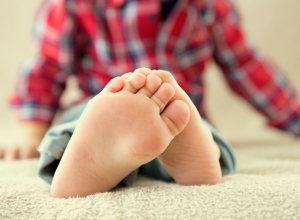
Pigeon Toe
Pigeon toe (also known as intoeing, false clubfoot, in-toe gait, forefoot varus, metatarsus varus and metatarsus adductus) is a condition in which an infant or child’s toes point inward.
Symptoms
Pigeon toe is most often noticed by parents when their child begins walking and typically shows itself via an inward position of one or both feet. Intoeing does not cause pain, but it may lead to a child frequently stumbling or tripping. If any pain or swelling is associated with intoeing, it is strongly recommended to get your child evaluated by an orthopaedic surgeon.
Types and Causes
Most cases of pigeon toe are the result of muscle weakness, but many cases arise from other conditions such as a twisted shin or thighbone. There are three different types of pigeon toe: Curved foot (metatarsus adductus), twisted shin (tibia torsion), and twisted thighbone (femoral anteversion).
- Metatarsus Adductus: The most common type of intoeing, metatarsus adductus, is when an infant or toddler’s feet bend inward starting at the middle part of the foot. Severity ranges from mild to extreme, with the most extreme cases resembling clubfoot. (However, intoeing is the not the same thing as clubfoot, a foot deformity which requires treatment immediately after birth.) Most cases of metatarsus adductus intoeing will improve on their own within a few months to half a year. If no improvement is seen within this time period, your doctor may suggest casts or special shoes. These typically come with a high success rate for improvement and healing.
- Twisted Shin (Tibial Torsion): Tibial torsion intoeing is characterized by a child’s lower leg (tibia) twisting inward, which then causes the feet to point inward, as well. It is usually caused by rotation of the baby inside his or her mother’s crowded womb during pregnancy. Some newborn’s legs gradually rotate and re-align naturally, whereas some do not, which creates the condition. Most cases of tibial torsion will improve on their own within the first couple of years of a child’s life. Generally, special shoes, splints, casting and braces do not help the condition improve.
- Twisted Thighbone (Femoral Anteversion): Twisted thighbone intoeing is the only type of the condition that often presents itself later in a child’s life — usually between the ages of five and six. Also known as excessive femoral torsion, it occurs when a child’s thighbone (femur) twists inward, which then causes both the knees and the feet to turn inward, as well. Femoral anteversion usually always self-corrects as a child grows older. Generally, special shoes, splints, casting and braces do not help the condition improve.
Treatment
As we mentioned above, almost all cases of pigeon toe will self-correct on their own. However, in rare cases, your child’s doctor or pediatric orthopedic surgeon may recommend surgery. If surgery is suggested, it is generally undergone when the child reaches an older age (usually between 9 and 10), and only if the deformity is severe enough to cause frequent tripping or extreme trouble walking.
Surgeries for pigeon toed children involve lengthening the Achilles tendon, re-setting the tibia bone or cutting the femur and rotating it into proper alignment.
Notice concerning medical entries:
Articles having medical content shall serve exclusively for the purpose of general information. Such articles are not suitable for any (self-) diagnosis and treatment of individual illnesses and medical indications. In particular, they cannot substitute for the examination, advice, or treatment by a licensed physician or pharmacist. No replies to any individual questions shall be effected through the articles.






